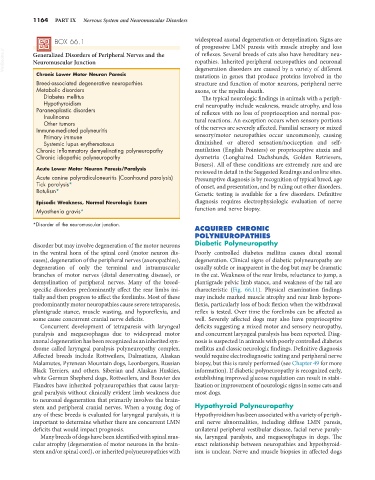Page 1192 - Small Animal Internal Medicine, 6th Edition
P. 1192
1164 PART IX Nervous System and Neuromuscular Disorders
BOX 66.1 widespread axonal degeneration or demyelination. Signs are
of progressive LMN paresis with muscle atrophy and loss
VetBooks.ir Generalized Disorders of Peripheral Nerves and the of reflexes. Several breeds of cats also have hereditary neu-
ropathies. Inherited peripheral neuropathies and neuronal
Neuromuscular Junction
Chronic Lower Motor Neuron Paresis degeneration disorders are caused by a variety of different
mutations in genes that produce proteins involved in the
Breed-associated degenerative neuropathies structure and function of motor neurons, peripheral nerve
Metabolic disorders axons, or the myelin sheath.
Diabetes mellitus The typical neurologic findings in animals with a periph-
Hypothyroidism eral neuropathy include weakness, muscle atrophy, and loss
Paraneoplastic disorders of reflexes with no loss of proprioception and normal pos-
Insulinoma
Other tumors tural reactions. An exception occurs when sensory portions
Immune-mediated polyneuritis of the nerves are severely affected. Familial sensory or mixed
Primary immune sensory/motor neuropathies occur uncommonly, causing
Systemic lupus erythematosus diminished or altered sensation/nociception and self-
Chronic inflammatory demyelinating polyneuropathy mutilation (English Pointers) or proprioceptive ataxia and
Chronic idiopathic polyneuropathy dysmetria (Longhaired Dachshunds, Golden Retrievers,
Boxers). All of these conditions are extremely rare and are
Acute Lower Motor Neuron Paresis/Paralysis reviewed in detail in the Suggested Readings and online sites.
Acute canine polyradiculoneuritis (Coonhound paralysis) Presumptive diagnosis is by recognition of typical breed, age
Tick paralysis* of onset, and presentation, and by ruling out other disorders.
Botulism* Genetic testing is available for a few disorders. Definitive
Episodic Weakness, Normal Neurologic Exam diagnosis requires electrophysiologic evaluation of nerve
Myasthenia gravis* function and nerve biopsy.
*Disorder of the neuromuscular junction.
ACQUIRED CHRONIC
POLYNEUROPATHIES
disorder but may involve degeneration of the motor neurons Diabetic Polyneuropathy
in the ventral horn of the spinal cord (motor neuron dis- Poorly controlled diabetes mellitus causes distal axonal
eases), degeneration of the peripheral nerves (axonopathies), degeneration. Clinical signs of diabetic polyneuropathy are
degeneration of only the terminal and intramuscular usually subtle or inapparent in the dog but may be dramatic
branches of motor nerves (distal denervating disease), or in the cat. Weakness of the rear limbs, reluctance to jump, a
demyelination of peripheral nerves. Many of the breed- plantigrade pelvic limb stance, and weakness of the tail are
specific disorders predominantly affect the rear limbs ini- characteristic (Fig. 66.11). Physical examination findings
tially and then progress to affect the forelimbs. Most of these may include marked muscle atrophy and rear limb hypore-
predominantly motor neuropathies cause severe tetraparesis, flexia, particularly loss of hock flexion when the withdrawal
plantigrade stance, muscle wasting, and hyporeflexia, and reflex is tested. Over time the forelimbs can be affected as
some cause concurrent cranial nerve deficits. well. Severely affected dogs may also have proprioceptive
Concurrent development of tetraparesis with laryngeal deficits suggesting a mixed motor and sensory neuropathy,
paralysis and megaesophagus due to widespread motor and concurrent laryngeal paralysis has been reported. Diag-
axonal degeneration has been recognized as an inherited syn- nosis is suspected in animals with poorly controlled diabetes
drome called laryngeal paralysis polyneuropathy complex. mellitus and classic neurologic findings. Definitive diagnosis
Affected breeds include Rottweilers, Dalmatians, Alaskan would require electrodiagnostic testing and peripheral nerve
Malamutes, Pyrenean Mountain dogs, Leonbergers, Russian biopsy, but this is rarely performed (see Chapter 49 for more
Black Terriers, and others. Siberian and Alaskan Huskies, information). If diabetic polyneuropathy is recognized early,
white German Shepherd dogs, Rottweilers, and Bouvier des establishing improved glucose regulation can result in stabi-
Flandres have inherited polyneuropathies that cause laryn- lization or improvement of neurologic signs in some cats and
geal paralysis without clinically evident limb weakness due most dogs.
to neuronal degeneration that primarily involves the brain-
stem and peripheral cranial nerves. When a young dog of Hypothyroid Polyneuropathy
any of these breeds is evaluated for laryngeal paralysis, it is Hypothyroidism has been associated with a variety of periph-
important to determine whether there are concurrent LMN eral nerve abnormalities, including diffuse LMN paresis,
deficits that would impact prognosis. unilateral peripheral vestibular disease, facial nerve paraly-
Many breeds of dogs have been identified with spinal mus- sis, laryngeal paralysis, and megaesophagus in dogs. The
cular atrophy (degeneration of motor neurons in the brain- exact relationship between neuropathies and hypothyroid-
stem and/or spinal cord), or inherited polyneuropathies with ism is unclear. Nerve and muscle biopsies in affected dogs

